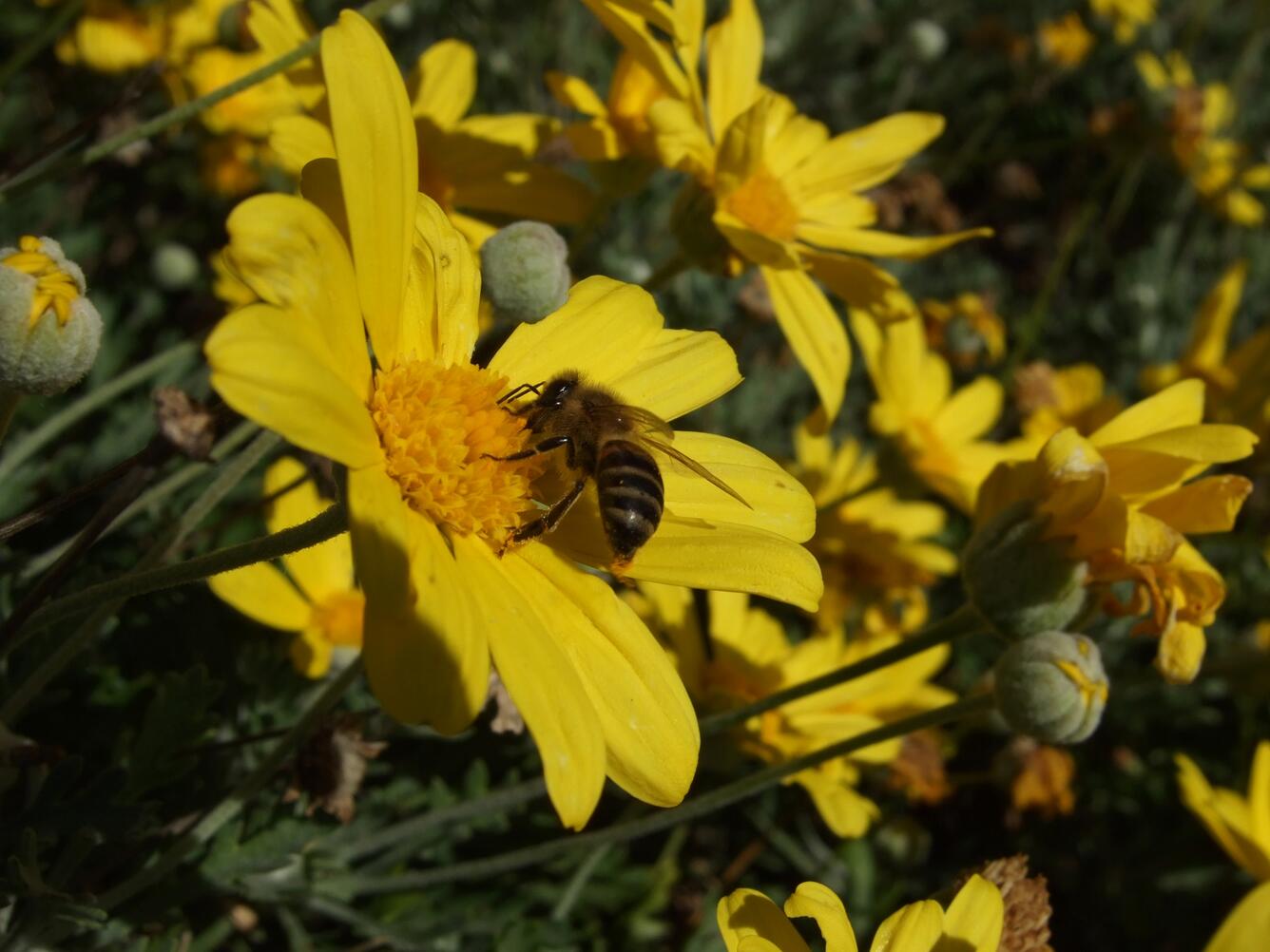It's Pollinator Week! Test your bee and other pollinator knowledge!
It’s pollinator week and USGS is providing science to better understand the status of pollinator species. Here’s the chance to test your knowledge about bees and other pollinators, with our pollinator week quiz! And let us know on FB or Twitter how you did!
Read the DOI Pollinator Week Proclamation!
Pollinator quiz questions:
Q1. True or False: Native bees occur on every continent on the planet.
Q2. True or False: There are about 4,000 species of bees in the U.S.
Q3. True or False: Pollinators are important to sustaining functioning ecosystems and food supplies for wildlife.
Q4. True or False: Bees feed on both nectar and pollen.
Q5. True or False: One bush or one clump of perennials is often all it takes to foster native bees in your yard.
Q6. True or False: The loss of plant diversity does not affect the health of native bees.
Q7. True or False. Along with bees, bats, birds and butterflies, some beetles are also pollinators.
Q8. True or False: Cows and fire matter to butterflies.
Q9. Yes or No. To bee or not to bee?
Q10. True or False: Monarch butterflies found east of the Rocky Mountains in North America migrate up to 4,500 km each fall.
See how well you did:
Answers:
A1. False. Native bees occur on every continent except Antarctica. Wherever there are insect-pollinated flowering plants — forest, farms, cities and wildlands — there are bees. And just because you don’t see plants blooming, does not mean that there are no bees around. https://www.usgs.gov/news/buzz-native-bees
A2. True. There are nearly 20,000 known bee species in the world, and 4,000 of them are native to the United States. From the tiny and solitary Perdita minima, known as the world’s smallest bee, to the large carpenter bee, to the brilliant blue of the mason bee; native bees come in a variety of shapes, sizes and colors. And all these bees have jobs, as pollinators https://www.usgs.gov/news/buzz-native-bees
A3. True: While the importance of a healthy pollinator population to agriculture is clear, pollinators are just as important to sustaining functioning ecosystems and food supplies for wildlife. The USGS works closely with federal, state, and other partners to better understand pollinator habitats and habitat requirements. https://www.usgs.gov/news/honey-bee-helpers-it-takes-village-conserve-colony
A4. True. Bees feed on both nectar and pollen – the nectar is for energy, and the pollen provides protein and other nutrients. Most pollen is used by bees as larvae food, but bees also transfer it from plant-to-plant providing the pollination services needed by plants and nature as a whole.https://www.usgs.gov/news/buzz-native-bees
A5: True. Bees are tiny; one bush or one clump of perennials is often all it takes to foster native bees in your yard. Within a mile of your yard (urban or rural) there are at least 100 species of bees looking for the right plants. Attracting and tending these native bees on your property is all about planting the right flowers and flowering bushes. https://www.usgs.gov/centers/pwrc/science/pollinators?qt-science_center_objects=0#qt-science_center_objects
A6. False. Loss of plant diversity is the primary cause of native bee decline, and 30-50% of all native bees are highly specialized.
A7. True. Bees, birds, butterflies, bats and beetles provide vital but often invisible pollination services that support terrestrial wildlife and plant communities, and healthy watersheds. Beetles are among the earliest prehistoric pollinators. https://www.usgs.gov/news/it-s-national-pollinator-week-get-buzz-usgs-pollinator-research
A8. True. For example, Minnesota’s tallgrass prairies depend on disturbance (e.g., fire, grazing, drought), without which they rapidly turn into woodland and forest. USGS researchers and their partners examined the direct and indirect effects of using fire or grazing to manage vegetation and influence pollinator diversity and abundance in Minnesota tallgrass remnant prairie. They found that burning and grazing favored different communities of bees, and butterflies, suggesting that each management type has a role in maintaining Minnesota's prairies. https://monarchjointventure.org/our-work/projects/effects-of-grazing-versus-fire-for-prairie-management
A9 Yes. To bee! Native bees pollinate plants like cherries, blueberries and cranberries, and were here long before European honeybees were brought here by settlers. Honeybees are well known for pollinating almond and lemon trees, okra, papaya and watermelon plants. But native bees are estimated to pollinate 80 percent of flowering plants around the world. According to the USDA, bees of all sorts pollinate approximately 75 percent of the fruits, nuts and vegetables grown in the United States, and one out of every four bites of food people take is courtesy of bee pollination. In sum, bee pollination is responsible for more than $15 billion in increased crop value each year. https://www.usgs.gov/news/it-s-national-pollinator-week-get-buzz-usgs-pollinator-research
A10. True. Monarch butterflies have one of the most spectacular animal migrations. East of the Rocky Mountains in North America, monarchs migrate up to 4,500 km each fall to overwinter in high-altitude fir forests in central Mexico,and west of the Rockies, monarchs overwinter in groves along the California coast. (https://www.frontiersin.org/articles/10.3389/fevo.2019.00167/full)
Thanks for testing your pollinator knowledge! Follow USGS this week on social media for more information on pollinators.
Get Our News
These items are in the RSS feed format (Really Simple Syndication) based on categories such as topics, locations, and more. You can install and RSS reader browser extension, software, or use a third-party service to receive immediate news updates depending on the feed that you have added. If you click the feed links below, they may look strange because they are simply XML code. An RSS reader can easily read this code and push out a notification to you when something new is posted to our site.











